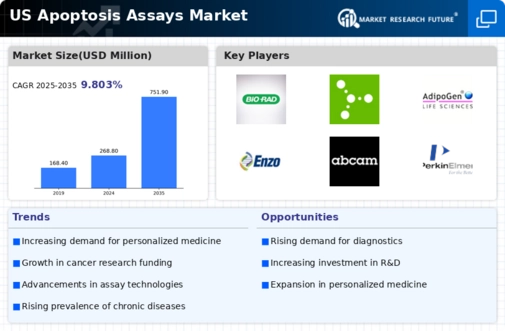Advancements in Assay Technologies
Technological innovations in assay development are transforming the apoptosis assays market. The introduction of high-throughput screening methods and improved imaging technologies has enhanced the sensitivity and specificity of apoptosis detection. For instance, flow cytometry and fluorescence microscopy are increasingly utilized to analyze apoptotic cells with greater precision. These advancements not only streamline the research process but also reduce the time and costs associated with apoptosis assays. As a result, researchers are more inclined to adopt these advanced techniques, thereby driving the growth of the apoptosis assays market. The market is projected to expand as these technologies become more accessible and user-friendly for laboratories across the US.
Rising Demand for Drug Development
The increasing demand for novel therapeutics is a significant driver for the apoptosis assays market. Pharmaceutical companies are under pressure to develop effective drugs that target specific pathways involved in apoptosis. This trend is particularly evident in the oncology sector, where the need for targeted therapies is paramount. According to industry reports, the US pharmaceutical market is expected to reach $600 billion by 2025, with a substantial portion allocated to cancer drug development. Apoptosis assays play a crucial role in this process, as they help in screening potential drug candidates and assessing their effects on cell death. Thus, the growth in drug development initiatives is likely to propel the apoptosis assays market forward.
Increased Focus on Biomarker Discovery
The heightened interest in biomarker discovery significantly influences the apoptosis assays market. Biomarkers are essential for diagnosing diseases, predicting treatment responses, and monitoring therapeutic efficacy. As researchers strive to identify new biomarkers related to apoptosis, the demand for reliable assays is surging. The US government has recognized the importance of biomarker research, leading to increased funding and support for related initiatives. This trend is expected to drive the apoptosis assays market, as researchers require sophisticated tools to validate and characterize these biomarkers. The integration of apoptosis assays into biomarker discovery workflows is likely to enhance their utility and relevance in clinical settings.
Increasing Cancer Research Initiatives
The growing emphasis on cancer research in the US is a pivotal driver for the apoptosis assays market. With cancer being one of the leading causes of death, funding and initiatives aimed at understanding cancer biology are on the rise. The National Cancer Institute has allocated substantial resources, with an estimated budget of $6.56 billion for cancer research in 2025. This influx of funding is likely to enhance the development and application of apoptosis assays, as researchers seek to explore the mechanisms of cell death in cancer cells. Consequently, the apoptosis assays market is expected to witness significant growth, as these assays are essential for evaluating the efficacy of new cancer therapies and understanding tumor biology.
Growing Awareness of Cell Death Mechanisms
The rising awareness of cell death mechanisms is a crucial driver for the apoptosis assays market. As scientific understanding of apoptosis and its role in various diseases expands, there is a corresponding increase in the demand for assays that can accurately measure apoptotic activity. Educational initiatives and publications in scientific journals are contributing to this awareness, fostering a culture of research focused on cell death pathways. This trend is likely to stimulate interest in apoptosis assays, as researchers seek to explore the implications of apoptosis in disease progression and treatment responses. Consequently, the apoptosis assays market is poised for growth as more laboratories incorporate these assays into their research agendas.






















Leave a Comment